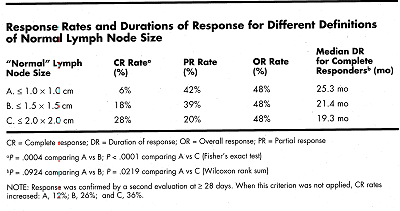Response Criteria for NHL: Importance of “Normal” Lymph Node Size and Correlations With Response
There are standard response criteria for solid tumors, chronic lymphocytic leukemia, Hodgkin’s disease, and acute myelogenous
There are standard response criteria for solid tumors, chronic lymphocytic leukemia, Hodgkins disease, and acute myelogenous leukemia but none for non-Hodgkins lymphoma (NHL). A panel was convened to develop response criteria for NHL (Proc Am Soc Clin Oncol, 1997), which were later endorsed by an international group of lymphoma experts (Proc Int Soc Exper Hematol, 1997).
The response criteria were applied by a third-party, blinded panel of NHL experts (LEXCOR) to a 166-patient study of rituximab (Rituxan). The database includes measurements for all measurable lesions, allowing a computerized evaluation of different sets of response criteria. We performed an analysis applying our rigorous criterion for normal lymph node size (£ 1 × 1 cm) compared with two alternative criteria (£ 1.5 × 1.5 cm and £ 2 × 2 cm).

As anticipated, our £ 1 × 1 cm criterion resulted in a lower complete response (CR) rate than the less stringent criteria. The overall response rate was not affected. Our response criteria also required a confirmatory evaluation at ³ 28 days after the first evidence of a response. When this criterion was not applied, a progressive increase in CR rates was seen: criteria A, B, and C; 12%, 26%, and 36%, respectively. There is no reason to restrict study entry according to lymph node size, as this did not affect response rates when our rigorous criteria were applied.
CONCLUSION: Efficacy of NHL anticancer agents must be carefully weighed in literature reports without clearly defined response criteria. Standard response criteria are now being developed by the National Cancer Institute (NCI) in collaboration with international experts and based on our rigorous response criteria for NHL.
Click here for Dr. Bruce Chesons commentary on this abstract.
Targeted Therapy First Strategy Reduces Need for Chemotherapy in Newly Diagnosed LBCL
December 7th 2025Lenalidomide, tafasitamab, rituximab, and acalabrutinib alone may allow 57% of patients with newly diagnosed LBCL to receive less than the standard number of chemotherapy cycles without compromising curative potential.